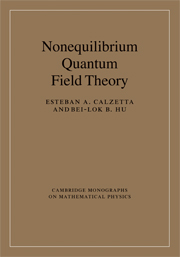Book contents
- Frontmatter
- Contents
- Preface
- I FUNDAMENTALS OF NONEQUILIBRIUM STATISTICAL MECHANICS
- II BASICS OF NONEQUILIBRIUM QUANTUM FIELD THEORY
- 4 Quantum fields on time-dependent backgrounds: Particle creation
- 5 Open systems of interacting quantum fields
- 6 Functional methods in nonequilibrium QFT
- III GAUGE INVARIANCE, DISSIPATION, ENTROPY, NOISE AND DECOHERENCE
- IV THERMAL, KINETIC AND HYDRODYNAMIC REGIMES
- V APPLICATIONS TO SELECTED CURRENT RESEARCH
- References
- Index
5 - Open systems of interacting quantum fields
from II - BASICS OF NONEQUILIBRIUM QUANTUM FIELD THEORY
- Frontmatter
- Contents
- Preface
- I FUNDAMENTALS OF NONEQUILIBRIUM STATISTICAL MECHANICS
- II BASICS OF NONEQUILIBRIUM QUANTUM FIELD THEORY
- 4 Quantum fields on time-dependent backgrounds: Particle creation
- 5 Open systems of interacting quantum fields
- 6 Functional methods in nonequilibrium QFT
- III GAUGE INVARIANCE, DISSIPATION, ENTROPY, NOISE AND DECOHERENCE
- IV THERMAL, KINETIC AND HYDRODYNAMIC REGIMES
- V APPLICATIONS TO SELECTED CURRENT RESEARCH
- References
- Index
Summary
As introduced in Chapter 1, for many problems in statistical mechanics one is interested in the detailed behavior of only a part of the overall system (call it the system) interacting with its surrounding (call it the environment). In field theory one can accordingly decompose the field describing the overall system ϕ = ϕS + ϕE into a sum of the system field ϕS and the environment field ϕE. This decomposition is always possible formally but only when there is a clear physical discrepancy between the two sectors will it be physically meaningful and technically implementable. The division could be made between slow and fast variables, low and high frequencies or light and heavy mass sectors. Drawing examples from cosmology, in the stochastic inflation scenario one regards the system field as containing only the lower modes and the environmental field as containing the higher modes with the division provided by the event horizon in de Sitter spacetime. A similar problem in quark-gluon plasma is to ascertain the effect of the hard thermal loops on the soft gluon modes. Another is the effect of the atoms in the noncondensate on the Bose–Einstein condensate (BEC). These cases will be discussed in later chapters.
Usually the reason for performing such a decomposition is because one is interested more in the details of the system (the “relevant” variables or the “distinguished” sector), and less in that of the environment (the “irrelevant” variables).
- Type
- Chapter
- Information
- Nonequilibrium Quantum Field Theory , pp. 148 - 169Publisher: Cambridge University PressPrint publication year: 2008

